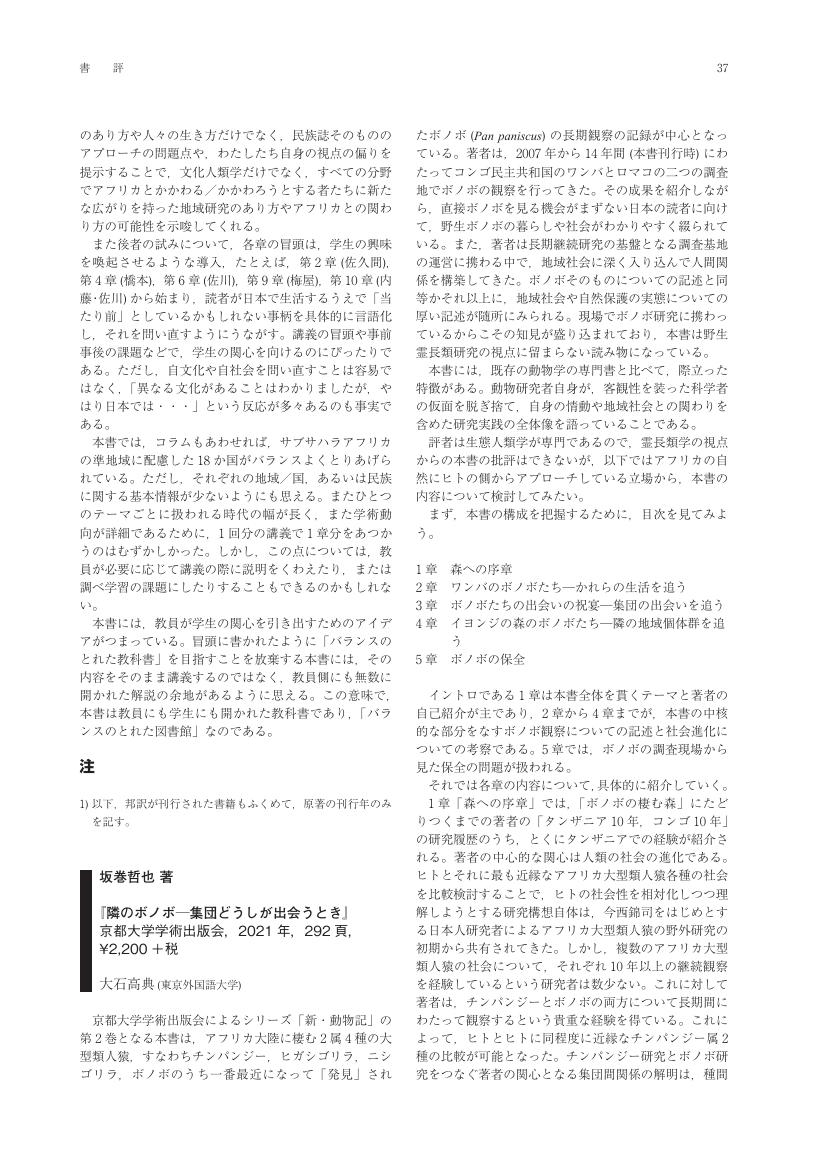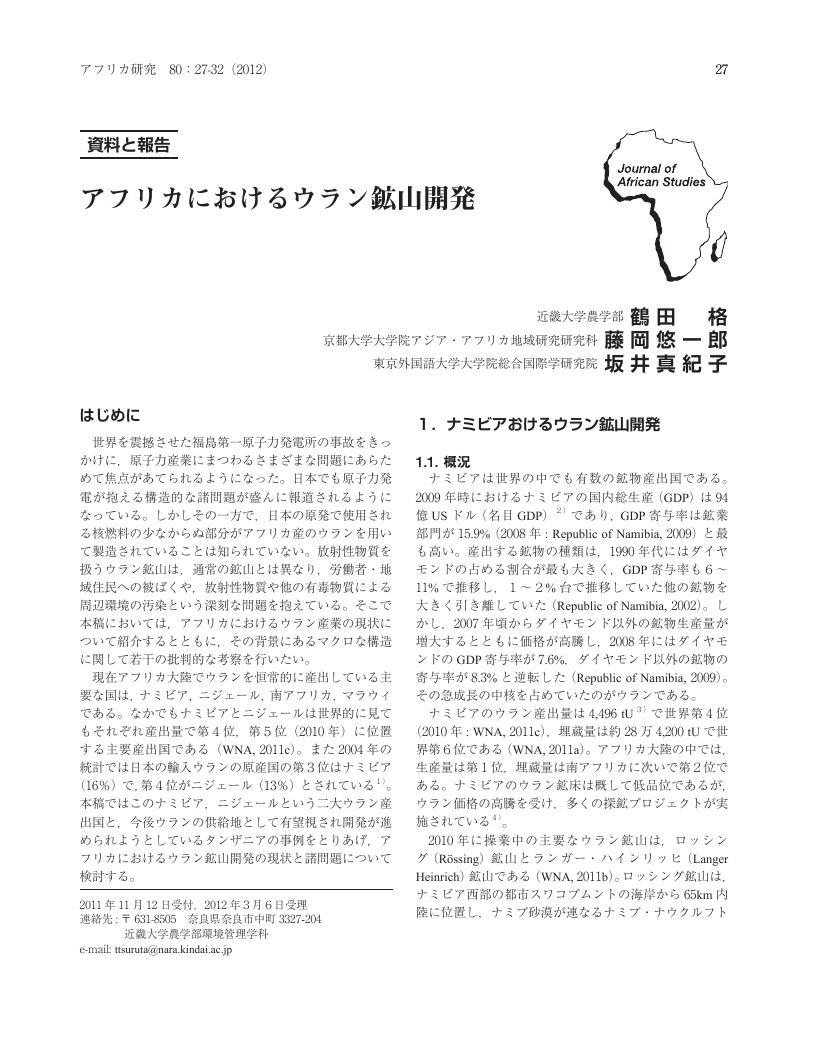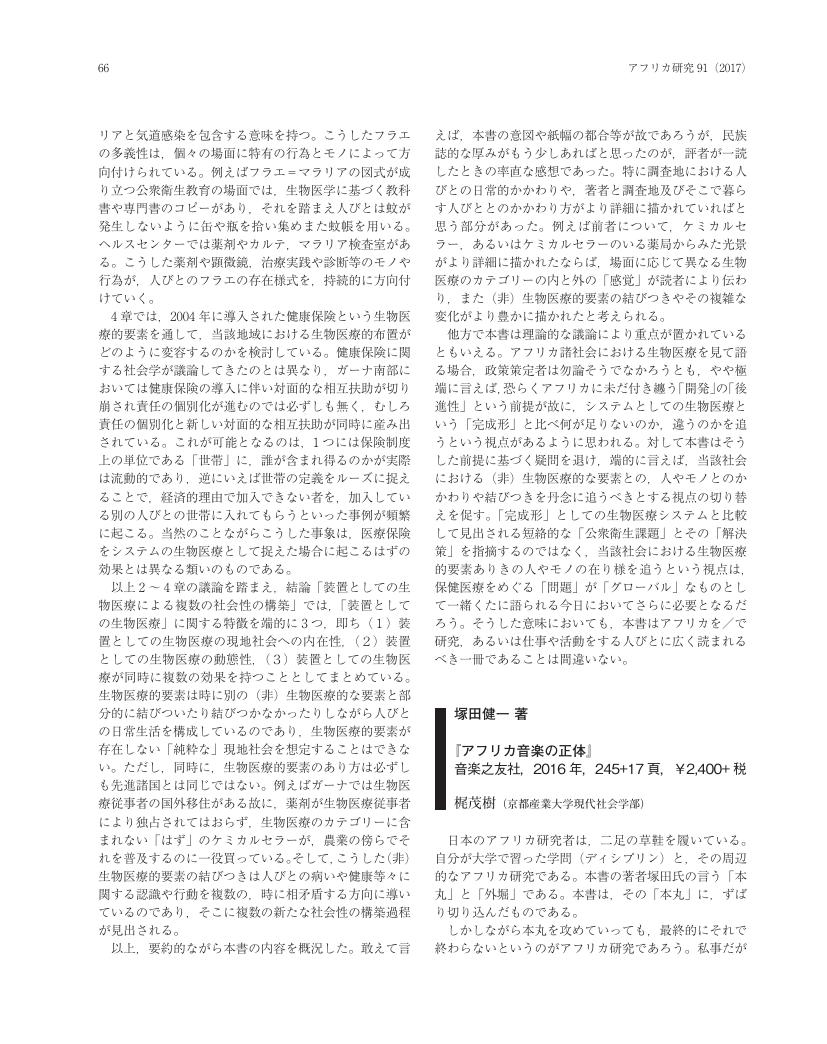10 0 0 0 OA アフリカの言語
- 著者
- 苅谷 康太
- 出版者
- 日本アフリカ学会
- 雑誌
- アフリカ研究 (ISSN:00654140)
- 巻号頁・発行日
- vol.2016, no.89, pp.1-13, 2016-05-31 (Released:2017-05-31)
- 参考文献数
- 37
19世紀初頭,現在のナイジェリア北部一帯に相当するハウサランドにおいて大規模な軍事ジハードが開始された。このジハードは,数年のうちに次々と同地のハウサ諸王権を圧倒し,一般にソコト・カリフ国と呼ばれる,イスラームを統治の基盤に据えた国家の建設を実現した。ジハードと国家建設の中心にいたイスラーム知識人ウスマーン・ブン・フーディー(1817年歿)は,複数の著作の中で,ハウサランドもしくはスーダーンに住む人々を信仰の様態に基づいて分類し,更に,その分類において不信仰者と見做した人々の捕虜・奴隷化に関する規定を論じている。本稿では,国家の基盤建設期にあたる1808年以降のウスマーンが,ウラマーの多くが認めていない法学的見解に依拠することを容認する「寛容の思想」を導入し,上述の信仰の様態に基づく人間の分類を操作することによって,捕虜・奴隷化し得る不信仰者の範疇を如何に拡大したのかを明らかにし,更に,その背景に如何なる理由が存在したのかを考察する。
7 0 0 0 OA 「伝統」を見せ物に「苦境」で稼ぐ ─「マサイ」民族文化観光の新たな展開─
- 著者
- 中村 香子
- 出版者
- 日本アフリカ学会
- 雑誌
- アフリカ研究 (ISSN:00654140)
- 巻号頁・発行日
- vol.2017, no.92, pp.69-81, 2017-12-31 (Released:2018-12-31)
- 参考文献数
- 22
本稿は,アフリカにおける民族文化観光においてもっとも長期的に有力な「商品」でありつづけている「マサイ」をとりあげ,彼らが住民主体でおこなう観光業の実態を検証することを目的とする。前半部では,民族文化観光の現場で何がどのように観光資源化されており,それによってどの程度の収益がもたらされているのかを明らかにし,そのうえで,観光業の経済基盤としての脆弱性を指摘する。人びとが「最少努力・最少投資」の姿勢で観光業に対峙していることをふまえて,後半部では,人びとが新たに民族文化観光の資源として利用しようとしているものを分析する。そのひとつは女性の「苦境」であり,もうひとつは子供の「苦境」である。いずれも国際社会による開発支援の定番のイメージであり,観光客が無意識に求めているもうひとつのステレオタイプ─「かわいそうなアフリカ」に合致するものである。「伝統」と「未開」を「光」としてみせ,「苦境」を「影」として聞かせながら,人びとは,観光客から新たな支援を呼び込む場として民族文化観光村を活用しているのである。
- 著者
- 大石 高典
- 出版者
- 日本アフリカ学会
- 雑誌
- アフリカ研究 (ISSN:00654140)
- 巻号頁・発行日
- vol.2022, no.102, pp.37-40, 2022-12-31 (Released:2023-12-31)
- 参考文献数
- 4
5 0 0 0 OA 特集にあたって アフリカの人口高齢化:西暦2100年を見据えた調査と政策策定へ向けて
- 著者
- 増田 研
- 出版者
- 日本アフリカ学会
- 雑誌
- アフリカ研究 (ISSN:00654140)
- 巻号頁・発行日
- vol.2016, no.90, pp.37-46, 2016-12-31 (Released:2017-12-31)
- 参考文献数
- 35
感染症による死亡率が低下したアフリカでは現在,人口が急増する一方で長寿命化が進行している。この延長線上に,今世紀後半にやってくるとされるアフリカの少子高齢時代をどのように迎えるのか,そのためにどのような調査や政策が求められるのか,という課題に関する問題整理を試みたのが本稿である。高齢化社会の到来をにらんだ取り組みとしては,年金や給付金制度の策定などがすでにいくつかの国で始まっているが,高齢者の生活ケアや健康・医療問題など,課題は多いとされる。アフリカ社会の高齢化に関する先行研究の多くは,社会保障の不在や非感染症への対応の遅れ,都市部貧困層の高齢化,農村社会の高齢化,ファミリーケアの衰退といった数多くの問題点を指摘する。しかしながら,個別社会において人口高齢化が何をもたらすのか,そもそも何が課題であるのか,そうした課題に地域社会の脈絡にそくしたどのような社会的対応がありうるのかといった点について,今後は民族誌的なアプローチによる研究が本格化されることが望ましい。高齢化先進国の社会保障政策や試行錯誤を参考にしつつも,地域社会のあり方に学び,アフリカの未来の姿についての関心を共有することが求められるのである。
4 0 0 0 OA アフリカにおけるウラン鉱山開発
4 0 0 0 OA 内戦,住民投票と「神話」の動態
- 著者
- 橋本 栄莉
- 出版者
- 日本アフリカ学会
- 雑誌
- アフリカ研究 (ISSN:00654140)
- 巻号頁・発行日
- vol.2012, no.81, pp.31-44, 2012-12-31 (Released:2014-03-28)
- 参考文献数
- 17
南スーダンに住まうヌエル社会の人々は,度重なる内戦を経験し,平和構築や住民投票,新国家の誕生という歴史的出来事に立ち会ってきた。多くのヌエルの人々は,これらの出来事をかつてなされた予言が成就したものとして捉えている。本稿の目的は,首都ジュバに住まうヌエルの人々が,南スーダンの分離独立という歴史的出来事を,19世紀末になされた予言という「神話」的枠組みを通してどのように捉えていたのかを報告することにある。人々は住民投票のプロセスの中で偶発的に出現する数々の要素を,かつての予言の中に見出すことによって分離独立の正しさを語っていた。本稿では多様な予言の解釈に注目し,語り手各々が抱える現実的な問題が予言を介して国家レベルの問題に接続されてゆく過程を描く。これを通じ,多様な背景を持つ人々が集うアフリカ都市社会において,戦後復興の一環である「民主化」への取り組みと,多様な解釈を通じて刷新される「神話」とがいかに人々の重層的なリアリティを形成してゆくのかを提示する。
- 著者
- 落合 雄彦
- 出版者
- 日本アフリカ学会
- 雑誌
- アフリカ研究 (ISSN:00654140)
- 巻号頁・発行日
- vol.2015, no.88, pp.42-45, 2015
4 0 0 0 OA ガボン南部バボンゴ・ピグミーの伝統儀礼を通じた外部世界との関係
- 著者
- 松浦 直毅
- 出版者
- 日本アフリカ学会
- 雑誌
- アフリカ研究 (ISSN:00654140)
- 巻号頁・発行日
- vol.2010, no.77, pp.19-30, 2010-12-31 (Released:2013-12-06)
- 参考文献数
- 38
多くのアフリカ諸国でみられるように,アフリカ中部のガボン共和国では,病気の治療や家族関係,仕事,そして政治的な問題の解決のためにおこなわれる伝統儀礼が,広く人びとのあいだで信じられ,利用されている。なかでも「ピグミー」と呼ばれる人びとは,豊富な植物の知識をもち,超自然的な力をそなえた存在として特別視されている。本稿では,ガボン南部のピグミーの1グループであるバボンゴの伝統儀礼について,以下の2点を明らかにする。(1)バボンゴは,周縁的な村に暮らしていながらも,伝統儀礼を通じて政治的な権力者を含めた都市の人びととの関係を築いている。(2)現金収入の乏しい村に暮らすバボンゴにとって,伝統儀礼が貴重な収入源となっている。これまでの研究では,ピグミーが周縁的な存在であるために,外部世界と関わるには近隣農耕民に対して政治的に依存せざるをえないこと,近代的な国家システムへの参与が困難であることが指摘されてきた。しかしながら,ガボン南部のバボンゴは,周縁的な存在であるために逆に外部の人びとから伝統儀礼が価値づけられ,その能力が頼られることで,農耕民に依存することなく外部世界とかかわり,伝統儀礼の担い手として独自の社会的地位を築いているといえる
3 0 0 0 OA ラクダの信託が生む絆
- 著者
- 曽我 亨
- 出版者
- 日本アフリカ学会
- 雑誌
- アフリカ研究 (ISSN:00654140)
- 巻号頁・発行日
- vol.1998, no.52, pp.29-49, 1998-03-31 (Released:2010-04-30)
- 参考文献数
- 24
This paper analyzes the “camel trust system” (dabare) of the Gabra, pastoralists in a Eastern Province of Kenya. Gabra people transfer their camels as gifts, and on the basis of short term loan, trade and “trust”.Trust, the most ordinary of these four, is a long term loan. Usually, an owner trusts out (loans) most of his camels to other Gabra, and he lives on camels trusted in (borrowed) from other Gabra. Trustees can keep trusted camels as long as the owner does not ask for their return. Trustees have the right of use of the camel and what it produces, most importantly milk. As well, trustees can in turn, trust offspring to another Gabra. Trustors and trustees are recognized as “jal” (special friend), connected by the trusting of camels. This “jal” chain creates multiple networks in the Gabra society.The first part of this paper outlines the trust system of the Gabra and analyzes the relationships which are found in the “jal” networks. There are two important relationships. One is a direct relationship between trustor and trustee, characterized by intimacy and loose reciprocity. The other is an indirect relationship between the owner of a camel and the trustees of that camel's offspring. A camel owner has the right to demand a gift from the trustee, however, in some cases, this demand is deemed too high, and the trustee does not accede to the owner's demand, in which case the owner will compulsorily recall his camel from that trustee. The latter relationship is particular to the Gabra trust system.Secondly, this paper analyzes three features which the trust system generates in the Gabra society. (1) Trust system organizes the Gabra into particular clan. The trust system strongly unites the owner's clan's members. As clans ideally own numerous camels, owners of camels and his clan members keep a close eye on trustees to ensure they breed a camel correctly. The trust system mobilizes and unites the members of the owner's clan. (2) Trust system have the Gabra conform themselves to the discipline. As the owner and his clan's members keep close watch on trustees, trustees try to keep the regulations of trusted camel. Moreover, as the owner who is offended with trustee often compulsorily recalls his camels form that trustee, trustees must always be deferent to camel owners. By virtue of these, trustee are obliged to assume a discipline-abiding attitude with respect to any Gabra who is closely watching him. (3) Trust system makes Gabra imagine the ethnicity. The owner and trustees often live in different region in Gabra land. Trust system connects these people who mutually live in “outside” of their daily-world. By virtue of these, the Gabra recognize the reality of their ethnicity.It is likely that these features resulted from the detachment of the right of ownership from the people who directly exchange the camels.
3 0 0 0 OA 南アフリカにおける原子力開発
- 著者
- 佐藤 千鶴子
- 出版者
- 日本アフリカ学会
- 雑誌
- アフリカ研究 (ISSN:00654140)
- 巻号頁・発行日
- vol.2012, no.80, pp.33-40, 2012-03-31 (Released:2014-01-25)
- 参考文献数
- 23
3 0 0 0 OA 岩田拓夫著『アフリカの地方分権化と政治変容』晃洋書房,2010年,170頁,¥2,500
- 著者
- 佐藤 章
- 出版者
- 日本アフリカ学会
- 雑誌
- アフリカ研究 (ISSN:00654140)
- 巻号頁・発行日
- vol.2010, no.77, pp.63-65, 2010-12-31 (Released:2013-12-06)
- 著者
- 玉井 隆
- 出版者
- 日本アフリカ学会
- 雑誌
- アフリカ研究 (ISSN:00654140)
- 巻号頁・発行日
- vol.2017, no.91, pp.65-66, 2017
- 被引用文献数
- 1
2 0 0 0 OA 八木さんと歩いたアフリカ
- 著者
- 山極 寿一
- 出版者
- 日本アフリカ学会
- 雑誌
- アフリカ研究 (ISSN:00654140)
- 巻号頁・発行日
- vol.2013, no.83, pp.89-92, 2013-12-31 (Released:2014-04-16)
2 0 0 0 OA 序論 ─プレザンス・アフリケーヌとは何か─
- 著者
- 佐久間 寛
- 出版者
- 日本アフリカ学会
- 雑誌
- アフリカ研究 (ISSN:00654140)
- 巻号頁・発行日
- vol.2018, no.94, pp.21-33, 2018-12-31 (Released:2019-12-31)
- 参考文献数
- 37
- 被引用文献数
- 1
本特集は,アフリカの脱植民地化に影響を及ぼしたことで知られる黒人文化総合誌『プレザンス・アフリケーヌ』創刊70周年に前後して同誌の共同研究を進めてきた文学・文化人類学の専門家による研究成果の集成である。『プレザンス・アフリケーヌ』誌は,A.セゼールやL.S.サンゴールといったカリブ・アフリカ出身の文化人にとってかけがえのない創作の場であったばかりでなく,政治,経済,歴史,教育等の専門家が集う学術分野を超えた集団討議の場でもあった。主要言語はフランス語であるが,英語圏からの執筆者もおおく,スペイン語やポルトガル語による作品も掲載された。また同誌は黒人のみに開かれていたわけではなく,創刊にはJ.-P.サルトルやA.ジッドといったフランスの白人知識人が参加した。またプレザンス・アフリケーヌは,アフリカ系知識人の作品を送りだしてきた出版社でもあり,第1回黒人作家芸術家会議をはじめとする歴史的イベントを組織した事業体でもある。序論である本稿では,言論媒体であると同時に多種多様な人々の交流と混淆を促す運動そのものでもあったプレザンス・アフリケーヌの相貌を概観し,この文化複合体を研究することの今日的意義を明らかにする。
2 0 0 0 OA 札幌からアフリカへ
- 著者
- 日野 舜也
- 出版者
- 日本アフリカ学会
- 雑誌
- アフリカ研究 (ISSN:00654140)
- 巻号頁・発行日
- vol.2015, no.86, pp.45-47, 2015-01-31 (Released:2015-05-21)
- 被引用文献数
- 2
- 著者
- 苅谷 康太
- 出版者
- 日本アフリカ学会
- 雑誌
- アフリカ研究 (ISSN:00654140)
- 巻号頁・発行日
- vol.2016, no.89, pp.1-13, 2016
19世紀初頭,現在のナイジェリア北部一帯に相当するハウサランドにおいて大規模な軍事ジハードが開始された。このジハードは,数年のうちに次々と同地のハウサ諸王権を圧倒し,一般にソコト・カリフ国と呼ばれる,イスラームを統治の基盤に据えた国家の建設を実現した。ジハードと国家建設の中心にいたイスラーム知識人ウスマーン・ブン・フーディー(1817年歿)は,複数の著作の中で,ハウサランドもしくはスーダーンに住む人々を信仰の様態に基づいて分類し,更に,その分類において不信仰者と見做した人々の捕虜・奴隷化に関する規定を論じている。本稿では,国家の基盤建設期にあたる1808年以降のウスマーンが,ウラマーの多くが認めていない法学的見解に依拠することを容認する「寛容の思想」を導入し,上述の信仰の様態に基づく人間の分類を操作することによって,捕虜・奴隷化し得る不信仰者の範疇を如何に拡大したのかを明らかにし,更に,その背景に如何なる理由が存在したのかを考察する。
- 著者
- 梶 茂樹
- 出版者
- 日本アフリカ学会
- 雑誌
- アフリカ研究 (ISSN:00654140)
- 巻号頁・発行日
- vol.2017, no.91, pp.66-69, 2017-05-31 (Released:2018-05-31)
- 参考文献数
- 4
- 著者
- 海野 るみ
- 出版者
- 日本アフリカ学会
- 雑誌
- アフリカ研究 (ISSN:00654140)
- 巻号頁・発行日
- vol.2010, no.77, pp.65-67, 2010-12-31 (Released:2013-12-06)
2 0 0 0 OA アフリカ都市出稼ぎ民の再部族化現象
- 著者
- 松田 素二
- 出版者
- 日本アフリカ学会
- 雑誌
- アフリカ研究 (ISSN:00654140)
- 巻号頁・発行日
- vol.1983, no.23, pp.1-33, 1983-05-28 (Released:2010-04-30)
- 参考文献数
- 72
- 被引用文献数
- 1
African urban studies of Anthropology have their origin in one ideal model, the dyachronic detribalization model. This model assumes that African urbanization can be regarded as a gradual process of detribalization in consequence of direct contacts with heterogeneous and powerful Western cultures. In the 1950's, members of the Rhodes-Livingstone School such as Gluckman, Mitchell and Epstein advocated a new approach for African urban studies on the basis of their field researches of copperbelt towns in Northern Rhodesia (now Zambia). They criticized the detribalization model and put forward the situational approach, which emphasized synchronic social relations. According to this approach, the social relations of African rural-urban migrants are in some situations based on their traditional tribal norms but in others are based on urban norms. The situational approach is a very useful one because it highlights the migrants' personal strategy in situational selections. It cannot, however, explain the retribalization phenomenon which prevails in the African metropolises today. Those urban migrants who come from rural areas do not break away from tribal social relations but on the contrary reorganize these tribal relations in order to live a stable life in the urban environment. The situational approach cannot explain the paradox of the retention of tribal relations in a strikingly urban context.This paper tries to resolve the problems of retribalization by analysing a re-organization process of social relations by the Maragoli migrants from Kerongo village, Western Kenya in Kangemi, a poor housing area in Nairobi. Kangemi, located in the northwest area of the city, is an urban colony for the Maragoli migrants. We can observe an actual re-organization process of various kinds of social relations there. In order to elucidate this process, this paper adopts the following procedures.1. Firstly, several social situations, where social relations are developed and organized, are chosen from the daily life of the migrants from Kerongo village in Kangemi. This paper extracts empirically eight situations, namely, (1) securing the first accomodation, (2) seeking permanent employment, (3) borrowing or lending money, (4) borrowing or lending daily goods, (5) drinking beer or local alcohol, (6) exchanging messages and information with their home village, Kerongo, (7) participating in church activities, (8) carrying the body of a migrant back to the home village and preparing and performing a ritual of “ilisyoma” in Nairobi.2. Secondly, the forms of re-organizing social relations in each situation are examined. The forms can be sorted into two types, network type and group type. According to the former type, whenever they confront difficulties in some situations of their daily life, the migrants set up a kind of association to deal with the difficulties. When they do not form an association but extend their personal social networks, this form is called the group type.3. Thirdly, the principles of re-organizing social relations are verified in each situation. The clan-lineage principle, the village-home-boy principle and the urban neighbourhood-locality principle are presented here. Thus, the migrants from Kerongo village living in Kangemi re-organize their social relations by using different forms and different principles in each situation.4. Although most parts of these re-organization processes can be presented as retribalization phenomena, this paper pays much more attention to a process organized by the home-boy principle. The study fourthly examines how the home-boy principle, which has been developed recently in town, is embedded and reinterpreted in a traditional and dominant ideology of unilineal descent. In order to provide the home-boy principle with legitimacy in the framework of the ideology of unilineality, the Kerongo villagers have adopted two stages








